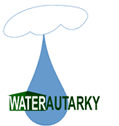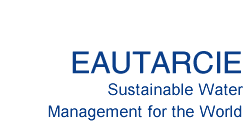
The EAUTARCIE concept is one of the possible forms of ecological sanitation, with a distinct feature: instead of doing an inventory of the problems, it rather goes to the source of these problems and proposes efficient, simple and inexpensive solutions. Its other main feature is its holistic approach, which takes into account various environmental impact issues.
In short, EAUTARCIE restores domestic water-related activities within Nature's great cycles: water, carbon, nitrogen and phosphorus.
To get a comprehensive overview of EAUTARCIE’s ecological sanitation principle, see our video on Youtube by clicking here.
To visualize the general schematic of a PLUVALOR system, click here![]() .
.
To visualize the general schematic of a Complete TRAISELECT system,
click here![]() .
.
The text within this page was first published in French on www.eautarcie.com : in April 2008
The original text has since been adapted and first published in English on this page at www.eautarcie.org : 2009-06-15
Last update : 2017-01-30


Ecological Sanitation and EAUTARCIE
Ecological Sanitation = « ECOSAN » ?
Ecological sanitation is a popular expression these days. It has even produced a neologism: ECOSAN, a generic term coined for the first time in 2000. A carryall notion where numerous and justifiable concerns are expressed, yet with shortcomings that betray incoherent guidelines. We herein propose EAUTARCIE’s version of ECOSAN –coined « SAINECO » in French – which applies principles that are clearly defined.
In most cases, the generic version of ECOSAN addresses issues whose relevance is sometimes debatable when you consider the overall perspective. They are:
Water conservation
Almost all recommendations made by officials and environmentalists address the issue of saving water. The public is made to feel guilty of consuming too much water when in reality, domestic water consumption accounts for only 10% of total water consumption. Water conservation only makes sense when you depend entirely on the public water distribution network. Once you decide to harvest rainwater for whole-house reuse, the situation becomes altogether different. Applying the 6th principle of EAUTARCIE’s version of ECOSAN will more likely resolve most water shortage problems, at least from a household’s perspective.
Pollution reduction by the use of environmentally friendly products
The use of environmentally friendly products (i.e. those that could end up in wastewater) makes sense only when wastewater is discharged into the sewers or in a conventional sanitation system. As soon as you apply the two first principles of EAUTARCIE’s version of ECOSAN, the environmental impacts need to be re-evaluated. All current studies on the environmental harmfulness of household products are based on conventional sanitation, whereby combined wastewater (black water and greywater) is sent into sewers for eventual treatment. Most of the time, this wastewater ultimately ends up in natural surface waters where residues of household cleaning products create problems for aquatic life as well as for mains water quality when supplied by said surface waters.
Under the 5th principle of EAUTARCIE’s ECOSAN, treated wastewater should not be discharged into a river except in quite exceptional situations. As soon as the different types of wastewater are selectively (separately) treated, the environmental impacts of household products are altogether different and should be re-assessed.
For example, the implementation of an appropriate greywater treatment technique nullifies the differences between « green » products and the others. In this context, it is better to view the use of « green » products as contributing to reduce the pressure on the environment thanks to a more envrionmentally-friendly manufacturing process. Thenceforth, the primary motive for using « green » products would not be to reduce pollution from the household.
Still, without properly taxing products in proportion to their environmental harmfulness, the protection of the environment depends entirely on an individual's motivation. One will have the choice between cheaper yet more polluting products or more expensive « green » products. Current worldwide legislation unfortunately does not effectively engage consumers’ responsibility.
Rainwater reuse for irrigation, cleaning and flush toilets
Considering the factual analyses and experience of hundreds of thousands of households, partial reuse of rainwater (for flush toilets, exterior taps, etc.) is somewhat wasteful and has limited impact when compared to whole-house reuse. Consider the PLUVALOR system, which is based on the 2nd and 6th principles of EAUTARCIE’s ECOSAN: rainwater use is prioritized first for human consumption, then personal hygiene. Its main purpose is not to save water or reduce the demand on the mains water system: the use of non-chemically treated water is meant as a safeguard for one’s health. Tenants of generic ECOSAN refuse to consider this concept by invoking the spectre of bacterial contamination.
Bath and shower grey water reuse for flush toilets
The use of shower and bath water to flush toilets poses a series of technical difficulties that cost more, with dubious results. In light of these and the existence of more interesting alternatives, one wonders if the effort is worthwhile.
Phytopurification of wastewater
Treatment of greywater and black water by means of plants (also commonly called phytoremediation) obeys to the same (bad) principles of conventional sanitation: sanitize to protect the environment. The 2nd principle of EAUTARCIE’s ECOSAN states that the more black water is treated, the more it pollutes and the greater the environmental destruction. As soon as greywater is treated separately from black water, the use of plants to purifiy wastewater can no longer be justified, except in special situations. It is easy to demonstrate that phytopurification is a harmful environmental wastage.
Using dry toilets
The various dry toilets proposed on the market have quite different environmental impacts. Some are probably even more polluting than standard WCs. For example, source-separating dry toilets have a greater negative environmental impact than the biolitter toilet (BLT), which applies the 2nd principle of EAUTARCIE’s version of ECOSAN. Environmentalists unfortunately do not make any distinction between the different types of dry toilets: for them, water conservation is the main environmental issue, whereas in fact it is a very minor aspect of the issue. The environmental impact of source-separating toilets cannot be understood if one does not recognize EAUTARCIE’s 3rd principle, which concerns the molecular structures within the soil, as essential to sustaining long-term agricultural production. When the emphasis is put on the outdated concept of N-P-K nutrient content, one cannot understand the importance of soil life and its symbiotic relation with plant roots. For example, when you use urine in the garden (collected from a source-separating toilet), you are actually « burning » the soil’s humus, and polluting ground water, just like liquid livestock manure that is spread on farmland.
Generic ECOSAN versus EAUTARCIE’s ECOSAN (SAINECO)
The Sustainable Sanitation Alliance (SuSanA) constitutes a school of thought that is consistent with the generic version of ECOSAN. To understand its priorities, it is useful to analyse SuSanA’s stand on sustainable sanitation (also see our web page http://www.eautarcie.org/en/04a.html#a):
« The main objective of a sanitation system is to protect and promote human health by providing a clean environment and breaking the cycle of disease. In order to be sustainable, a sanitation system has to be not only economically viable, socially acceptable, and technically and institutionally appropriate, it should also protect the environment and the natural resources. »
Thus the « main objective » is to protect human health and break « the cycle of disease ». On the other hand, EAUTARCIE’s version of ECOSAN prioritizes the return of human and animal dejecta within the cycles that form humus for the soil. Once these conditions are met, facts show that the safeguard of human health follows automatically. Conversely, when you prioritize « protection of human health », you risk bypassing aspects that are essential to the safeguard of the biosphere. At least, that is what the facts show, considering the techniques recommended by SuSanA. The « cycle of disease » is a questionable notion. The same goes for other such assertions as « we drink 90% of our maladies ». In most cases, disease is a result of a generalized weakening of a population’s immune system, not as a result of external factors. Here also, priorities should be reversed: instead of combatting reputedly pathogenic micro-organisms, it would be better to take measures to reinforce a population’s immune system. From that point, maladies would no longer be « cyclic ».
Ideas such as the « cycle of disease » are mainly put forth in the context of developing countries where sanitary conditions are often deplorable. We do not seem to realize that these conditions are not inevitable, and that improving such conditions does not necessarily pass through the techniques advocated by SuSanA’s ECOSAN, namely the implementation of mains water systems, latrines, source-separating dry toilets, sewers, wastewater treatment plants, etc. These techniques, and especially centralized water distribution and sewerage networks, don’t even meet SuSanA’s definition of « economic viability » . They obey to only one thing: « institutional appropriateness », whereby the proposed techniques meet existing legal requirements. We have not come to realize that water management legislation worldwide does not defend the environment, but only protects mainstream convention and the interests of water sector multinationals. Protecting the environment becomes a pretext for making money.
Poor hygiene conditions in developing countries can be mitigated by simple inexpensive techniques, without requiring extensive capital. As soon as you apply the six principles of EAUTARCIE’s version of ECOSAN, truly sustainable sanitation becomes accessible to the poorest countries, with relatively insignificant means, when compared to those recommended by international water experts. By heeding these experts’ ideas, it is to be feared that truly sustainable sanitation will not take place any time soon... The first decisive step for this to take place would require incorporating EAUTARCIE’s six principles in water legislation, which currently prohibits preventive techniques that would go to the root of the problem. At the least, legislation could be simplified by applying the first five principles of EAUTARCIE’s ECOSAN (or SAINECO).
It is significant to note that in SuSanA‘s definition for sustainable sanitation, « protecting the environment and the natural resources » comes last of all. Conversely, this is the main priority for EAUTARCIE’s ECOSAN. Protecting human health is an automatic offshoot from this, which is exemplified by an example from the Congo (see article «
The Philosophy behind EAUTARCIE's version of ECOSAN
An anthropocentric view
Tenants of generic ECOSAN don’t perceive its underlying anthropocentric principles, in which humans are viewed as the centre of the universe and of all interests. Sanitation is primarily in the service of man’s mental and intellectual comfort, most importantly in the « protection of human health » for one and all. Healthy life-sustaining ecosystems (for humans and all other living beings) come after... well after.
This is a tangible fact, not an intellectual theory. Chemical agriculture, with its synthetic fertilizers, pesticides and its contempt for soil life is one of the most significant manifestations of this philosophy. There are many other well known examples... It is no secret that man has already destroyed much of the biosphere, but he is also doing away with thousands of animal species. The official discourse on « biodiversity » is deceiving, and shows no tangible results. What is most worrisome is the overriding importance given to the economy, or more precisely money, hence such economic approaches as « the Blue Economy ». The success of these is no coincidence : if by these, the environment can be partly spared, the better it gives one a good conscience, as long as economic profitability always comes first.
The convenience offered by flush toilets or source-separating dry toilets, centralized sewerage and centralized drinking water supply is held to comply with man’s interests, traditions, beliefs and « social acceptance » (see previous text on SuSanA).
The biocentric view - Gaia
In EAUTARCIE’s SAINECO approach, man is simply part of the biosphere, on the same level as all living beings on our planet. The gorilla, hippo, crocodile, panda, elephant, tiger, whales, bees and all other living beings (even the so-called parasites) are entitled to living space that meets their needs and ensures their well-being. Some call this the « Gaia hypothesis » or the « biogeochemical hypothesis ». Personally, I would simply call this « biocentric » because life (bios : representing all living beings) is its central concern.
From that point, one can come to understand that EAUTARCIE’s SAINECO purposes to safeguard the health of the biosphere, not only human health. A healthy biosphere is the necessary foundation for human health. To repair the damages brought on by the anthropocentric approach, we must abandon the « all-to-the-sewer » system (a flagship of this approach). Meanwhile, we must restore the link between wastewater treatment and global food production. For humanity and the planet, there is no better path to a viable and sustainable world.
Conclusion
EAUTARCIE's strongpoint is the integration of mutually dependent relations that involve water management, plant and animal biomass and their influences on climate change. Once you acknowledge these interdependencies, it becomes immediately possible to propose a global program to get humanity out of its food and water shortage problems by reclaiming damaged ecosystems. Such a program, much less expensive that current proposals that only address global drinking water issues, would have an impact that could slow or even end climate change, if done concurrently to a reduction program of global energy consumption.
To continue your reading, go to Failings of sanitary engineering




